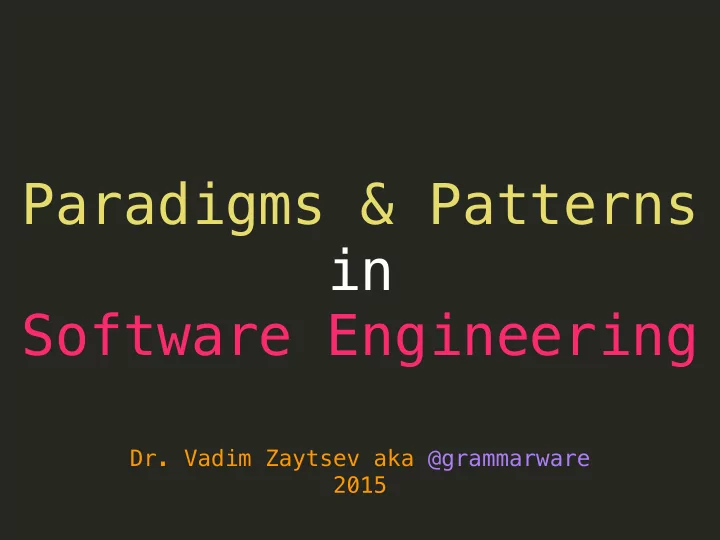

Paradigms & Patterns in Software Engineering Dr. Vadim Zaytsev aka @grammarware 2015
Questions * 51 (or 55) students * 47 reactions * 76 questions
Questions/Student 30 24 18 12 6 0 0 1 2 3 4
Questions [1/3] * What is a UML diagram? * Types of patterns (milli/nano/micro) * What is an antipattern? * Design patterns in FP or non-OO PLs?
Example: Bridge Abstraction Implementation operation() implementedOp() Refined Abstraction Refined Implementation implementedOp() operation()
E/R diagram https://docs.kde.org/trunk4/en/kdesdk/umbrello/uml-elements.html
Sequence diagram https://docs.kde.org/trunk4/en/kdesdk/umbrello/uml-elements.html
Collab diagram https://docs.kde.org/trunk4/en/kdesdk/umbrello/uml-elements.html
State diagram https://docs.kde.org/trunk4/en/kdesdk/umbrello/uml-elements.html
Activity diagram https://docs.kde.org/trunk4/en/kdesdk/umbrello/uml-elements.html
Use case diagram https://docs.kde.org/trunk4/en/kdesdk/umbrello/uml-elements.html
Questions [1/3] * What is a UML diagram? * Types of patterns (milli/nano/micro) * What is an antipattern? * Design patterns in FP or non-OO PLs?
Questions [2/3] * When which paradigms are used? * Which DPs are used the most in SE? * Patterns vs antipatterns * how to see if good or bad * how common they are * How to choose the right DP * How to learn ( to recognise ) patterns?
Most used patterns * MVC * Singleton * Observer * Façade * Iterator * Interpreter (& Visitor) http://programmers.stackexchange.com/questions/7055/what-is-the-most-frequently-used-design-pattern
Visitor vs Interpreter A Case of Visitor versus Interpreter Pattern Mark Hills 1 , 2 , Paul Klint 1 , 2 , Tijs van der Storm 1 , and Jurgen Vinju 1 , 2 1 Centrum Wiskunde & Informatica, Amsterdam, The Netherlands 2 INRIA Lille Nord Europe, France Abstract. We compare the Visitor pattern with the Interpreter pattern, investigat- ing a single case in point for the Java language. We have produced and compared two versions of an interpreter for a programming language. The first version makes use of the Visitor pattern. The second version was obtained by using an automated refactoring to transform uses of the Visitor pattern to uses of the Interpreter pattern. We compare these two nearly equivalent versions on their maintenance character- istics and execution efficiency. Using a tailored experimental research method we can highlight differences and the causes thereof. The contributions of this paper are that it isolates the choice between Visitor and Interpreter in a realistic software project and makes the difference experimentally observable. 1 Introduction Design patterns [ 7 ] provide reusable, named solutions for problems that arise when designing object-oriented systems. While in some cases it is clear which pattern should be used, in others multiple patterns could apply. When this happens, the designer has to carefully weigh the pros and cons (“consequences” [ 7 ]) of each option as applied both to the current design and to plans for future evolution of the system. In this paper we describe one of these choices in the context of an interpreter for the Rascal 1 programming language [ 13 ], namely: the choice between structuring an abstract syntax tree-based language interpreter according to either the Visitor or the Interpreter pattern. While it seems clear (Section 3) that either pattern will do from a functional point of view, it is unclear what the non-functional quality of the interpreter will be in each case. In theory, the Interpreter pattern might have lower method call overhead because it does not involve double dispatch, it should allow easier extension with new language features, and it should be easier to add local state to AST nodes. In theory, the Visitor pattern should allow easier extension with new kinds of operations on AST nodes and should allow better encapsulation of state required by such operations. These and other considerations are exemplified in what has become known as the “expression problem” [ 18 , 4 ]. In this paper we investigate how the assumptions embedded in the expression problem manifest themselves in the context of a concrete case. Our initial implementation of the Rascal interpreter was fully based on the Visitor design pattern. This choice was motivated mainly by a general argument for modularity, with each function (or algorithm) on the AST hierarchy separated into a single class. To be able to experiment with the decision of whether to use Visitor or Interpreter, we 1 http://www.rascal-mpl.org http://homepages.cwi.nl/~storm/publications/visitor.pdf
Questions [2/3] * When which paradigms are used? * Which DPs are used the most in SE? * Patterns vs antipatterns * how to see if good or bad * how common they are * How to choose the right DP * How to learn ( to recognise ) patterns?
Questions [3/3] * FP = bad performance? * When to optimise? * How to avoid smells?
Topics * Practical functional programming * Automated clone detection * Search-based software engineering * Software language engineering * Testing and quality control * Reverse engineering * Metaprogramming & program analysis * Language X / framework Y
Get yo auditors! Questions?
Recommend
More recommend